Click on images to enlarge
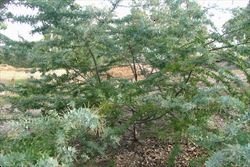
upright and spreading habit (Photo: Sheldon Navie)

habit in flower (Photo: Sheldon Navie)

the bluish-green twice-compound leaves (Photo: Sheldon Navie)

the lowest pair of branchlets on each leaf are shorter and angled backwards (Photo: Sheldon Navie)
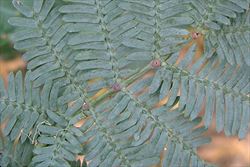
close-up of a leaf showing the small raised structures (i.e. glands) at the junction of the leaf branchlets (Photo: Sheldon Navie)

the undersides of the leaves are sometimes slightly hairy (Photo: Sheldon Navie)
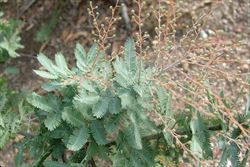
young flower clusters (Photo: Sheldon Navie)

drooping, elongated, compound flower clusters made up of many small globular flower clusters(Photo: Rob and Fiona Richardson)
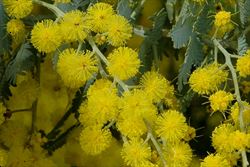
close-up of small globular flower clusters with prominent stamens (Photo: Rob and Fiona Richardson)
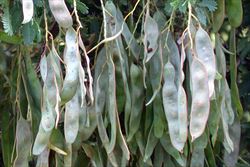
bluish-green immature fruit (Photo: Rob and Fiona Richardson)

the reddish-brown fruit split open when fully mature (Photo: Sheldon Navie)

close-up of seeds with small fleshy arils (Photo: Steve Hurst at USDA PLANTS Database)

habit of Acacia baileyana 'Purpurea', with purplish-tinged young foliage (Photo: Sheldon Navie)

close-up of the reddish-purple tinged foliage tips of Acacia baileyana 'Purpurea' (Photo: Sheldon Navie)
Scientific Name
Acacia baileyana F. Muell.
Synonyms
Acacia baileyana F. Muell. var. aurea PescottAcacia baileyana F. Muell. var. baileyanaRacospermum baileyanum (F. Muell.) Pedley
Family
Fabaceae: sub-family Mimosoideae (New South Wales)Leguminosae (South Australia)Mimosaceae (Queensland, the ACT, Victoria, Tasmania, Western Australia and the Northern Territory)
Common Names
Bailey's wattle, Cootamundra wattle, golden mimosa
Origin
This species has a very limited natural distribution in south-eastern Australia. It is native to the Temora, Cootamundra, Stockinbingal and Bethungra districts in the inland parts of southern New South Wales.
Cultivation
Cootamundra wattle (Acacia baileyana) is widely cultivated in parks, gardens and as a street tree in many parts of Australia (particularly in temperate and sub-tropical areas). In fact, it is probably the most commonly cultivated wattle in Australia.
Several cultivars, that differ form the description given here, are grown as ornamentals including: a cultivar with purplish-coloured young foliage (Acacia baileyana 'Purpurea'); a cultivar with yellowish-coloured young foliage (sometimes called Acacia baileyana 'Aurea'); a cultivar with reddish-coloured young foliage (sometimes called Acacia baileyana 'Rubra' or Acacia baileyana 'Rubrum'); and a low-growing cultivar that grows as a dense carpet (sometimes called Acacia baileyana 'Prostrata').
Naturalised Distribution
Naturalised in south-eastern Queensland, south-western Western Australia, many parts of Victoria, south-eastern South Australia (including Kangaroo Island) and the ACT. It is most widespread and troublesome in Victoria, particularly in the central and western parts of the state, and is relatively common in the hills and plains around Adelaide in south-eastern SA. It has also become naturalised in many parts of New South Wales beyond its native range, particularly in coastal districts and on the central and southern tablelands. Cootamundra wattle (Acacia baileyana) has also been reported as a weed in Tasmania, however this has not been confirmed by herbarium records.
This species has also become naturalised in other parts of the world, including southern Africa, New Zealand and south-western USA (i.e. California).
Habitat
This species grows naturally in open woodlands (e.g. mallee communities), primarily in stony or hilly country, in the inland parts of southern New South Wales.
It has become a weed of open woodlands, heathlands, grasslands, forest plantations, roadsides, disturbed sites, waste areas and watercourses (i.e. riparian vegetation) in the temperate and sub-tropical regions of Australia.
Habit
An upright (i.e. erect) shrub or small tree with a spreading crown. It usually grows 3-6 m tall, but occasionally reaches up to 10 m in height.
Distinguishing Features
- a large shrub or small tree with twice-compound leaves that are usually silvery-grey or bluish-grey in appearance.
- its leaves are almost stalkless, with the lowest pair of branchlets on each leaf being smaller and angled backwards.
- its golden yellow flowers are borne in small globular clusters, which are arranged into larger elongated clusters.
- its elongated and flattened pods (3-12 cm long) are hairless and turn brown or reddish-brown as they mature.
- these fruit are bluish-green and covered in a whitish powdery substance when they are young.
Seedling
Seedlings have two undivided seed leaves (i.e. cotyledons). The first true leaves are twice-compound (i.e. bipinnate), but only have two pairs of branchlets (i.e. pinnae), each bearing several pairs of tiny leaflets (i.e. pinnules).
Stems and Leaves
The bark on older branches is smooth and either grey or brown in colour. The base of the trunk of mature trees can be up to 25 cm across. Younger branches are sometimes rounded, but more commonly they are angled or somewhat flattened towards their tips. These branches are hairless (i.e. glabrous) or can occasionally have some spreading hairs (i.e. pubescent), and often also have a waxy coating (i.e. they are pruinose). The tips of young foliage are usually a distinctive bluish-green colour, though in some plants they are purplish or reddish.
The leaves are twice-compound (i.e. bipinnate) and usually have a somewhat greyish-green, silvery-grey or bluish-grey appearance. These leaves (30-65 mm long) are alternately arranged along the stems and almost stalkless (i.e. sub-sessile). They consist of a swollen base (i.e. pulvinus) 2-5 mm long and a main stalk (i.e. rachis) bearing 2 to 4 (occasionally 5 or 6) pairs of branchlets (i.e. pinnae). The lowest pair of branchlets are usually smaller than the others and angled backwards (i.e. reflexed). The main stalk, which is usually only 1-4 cm long, has a small raised structure (i.e. gland) at the junction of the uppermost one to three pairs of branchlets. Each branchlet is 1-3 cm long and bears numerous (8-24) pairs of relatively small oblong or elongated leaflets (i.e. pinnules). These leaflets (3-9 mm long and 0.7-1.6 mm wide) are hairless and usually have pointed tips.
Flowers and Fruit
The tiny golden yellow flowers are fluffy in appearance due to the presence of numerous stamens. These flowers have five relatively inconspicuous petals and sepals and are densely arranged into small globular clusters (6-8 mm across) containing 11-25 flowers. The globular flower clusters are borne on short slender stalks (i.e. peduncles) 4-7 mm long and are alternately arranged on a branch emanating from the forks (i.e. axils) of the leaves, or occasionally at the tip of the stem. These much larger elongated compound clusters (5-10 cm or more long), containing 8-30 of the small globular flower clusters, may or may not be branched (i.e. they form inflorescences resembling racemes or panicles) and are significantly longer than the leaves. Flowering generally occurs during late winter and spring, but may occasionally last into early summer in cooler climates.
The fruit is an elongated pod (30-120 mm long and 8-15 mm wide) that is borne on a short stalk. These pods are flattened, hairless (i.e. glabrous), and either straight or slightly curved. They are bluish-green in colour and covered in a whitish powdery substance when young (i.e. pruinose), but turn brown or reddish-brown as they mature.When fully mature they split open to release up to 12 dark brown to black seeds. Fruit are normally present during late spring and summer (i.e. from October to January). The seeds (4-7 mm long and 2-4 mm wide) are hard-coated and have a small fleshy structure (i.e. aril) attached to them.
Reproduction and Dispersal
Reproduction in this species is by long-lived seeds, that tend to accumulate in the soil and germinate readily after fire or other forms of disturbance.
Seeds may be dispersed short distances when the pods split open explosively in hot weather, and by ants that collect the seeds and take them to their nests. The relatively light and papery pods may also be spread some distance by wind and water. As this species is commonly cultivated, one of the main means of dispersal is in dumped garden waste. Longer distance dispersal can also occur when contaminated soil or mud is transported by vehicles.
Environmental Impact
Cootamundra wattle (Acacia baileyana) is regarded as a significant environmental weed in Victoria and the ACT. It is also considered to be a relatively important or emerging environmental weed in south-eastern South Australia, south-western Western Australia, south-eastern Queensland, Tasmania, and many parts of New South Wales that are beyond its natural range (particularly in coastal districts and in the Blue Mountains region).
This species has been widely cultivated throughout Australia since the 1800's and has spread from these ornamental plantings into native ecosystems, particularly in south-eastern Australia. When grown beyond its natural range it readily invades intact open woodlands, heathlands, grasslands and dry eucalypt woodlands on a variety of soil types. It also becomes naturalised along watercourses (i.e. in riparian vegetation) and roadsides.
Cootamundra wattle (Acacia baileyana) can displace other wattles (Acacia spp.) that are native to a particular area, and can also form dense stands that shade out other native plants. It is known to hybridise with other species of wattle, thereby partially replacing natural populations of these species with unnatural hybrids. In addition to this, because it fixes nitrogen in the soil, dense infestations can significantly increase soil fertility. This can make the soil less suitable for the growth of many native plants, and invaded areas can them become more vulnerable to invasion by other weed species.
Legislation
This species is declared under legislation in the following states and territories:
- ACT: C4 - prohibited - a pest plant whose supply is prohibited in the ACT.
Management
For information on the management of this species see the following resources:
- the Cootamundra Wattle page on the Weeds of Blue Mountains Bushland website at http://www.weedsbluemountains.org.au/index.asp.
- the Weeds in your Bush section of the Tasmanian Bushcare Toolkit which is available online at http://www.dpiw.tas.gov.au.
- the Woody Weeds Information Pamphlet on the Environmental Weeds Action Network (EWAN) website at http://members.iinet.net.au/~ewan/.
- the Cootamundra Wattle page on the South Coast Weeds website at http://www.esc.nsw.gov.au/Weeds/index.asp.
- Muyt (2001), Bush Invaders of South-east Australia, pp. 228-230.
- Moore and Wheeler (2002), Southern Weeds and their Control, pp. 134-140.
Similar Species
Cootamundra wattle (Acacia baileyana) may be confused with several other species of native wattles (Acacia spp.), particularly those that have silvery-grey twice-compound leaves. Similar species include silver wattle (Acacia dealbata subsp. dealbata) and karri wattle (Acacia pentadenia). These species can be distinguished by the following differences:
- Cootamundra wattle (Acacia baileyana) has silvery-grey twice-compound (i.e. bipinnate) leaves with a few (2-6) pairs of branchlets (i.e. pinnae). These leaves are almost stalkless (i.e. sub-sessile) and the lowermost pair of branchlets (i.e. pinnae) are angled backwards (i.e. reflexed). Its flowers are borne in small globular clusters, with several to many of these clusters being arranged into larger elongated compound clusters (i.e. racemes or panicles). The pods are relatively large (30-120 mm long and 8-15 mm wide) and flattened.
- silver wattle (Acacia dealbata subsp. dealbata) has silvery-grey twice-compound (i.e. bipinnate) leaves with numerous (10-30) pairs of branchlets (i.e. pinnae). These leaves are shortly stalked (i.e. petiolate) and the lowermost pair of branchlets (i.e. pinnae) are not angled backwards (i.e. not reflexed). Its flowers are borne in small globular clusters, with several to many of these clusters being arranged into larger elongated compound clusters (i.e. racemes or panicles). The pods are relatively large (20-115 mm long and 6-14 mm wide) and somewhat flattened.
- karri wattle (Acacia pentadenia) has dark green twice-compound (i.e. bipinnate) leaves with a few (2-5) pairs of branchlets. These leaves are almost stalkless (i.e. sub-sessile) and the lowermost pair of branchlets (i.e. pinnae) are very small and not angled backwards (i.e. not reflexed). Its flowers are borne in small globular clusters, with only a few (2-4) of these clusters being arranged into short compound clusters. The pods are relatively small (20-50 mm long and only 3-4 mm wide).
Hybrids of Cootamundra wattle (Acacia baileyana) and several other wattles (Acacia spp.) are known to occur, and outside the native range of this species these hybrids are also considered to be weeds. Such hybrids can be very similar to Cootamundra wattle (Acacia baileyana), but are usually intermediate in appearance between the two species involved. The most commonly occurring hybrid is between Cootamundra wattle (Acacia baileyana) and silver wattle (Acacia dealbata subsp. dealbata).
Note: This page only covers those species that have been reported to be commonly confused with Cootamundra wattle (Acacia baileyana). For a more in-depth key to all of the wattle species present in Australia see the Wattle: Acacias of Australia CD-ROM or Flora of Australia, Volumes 11A and 11B.

